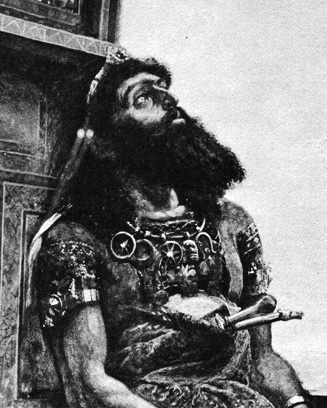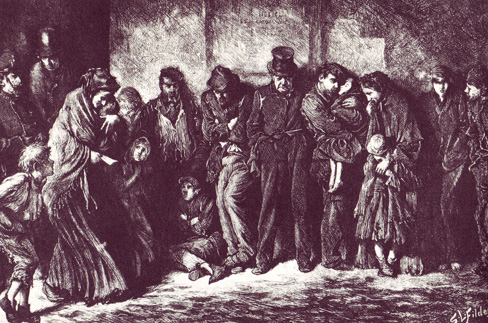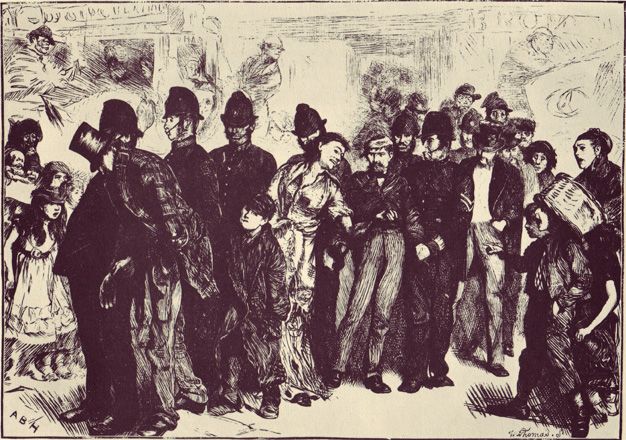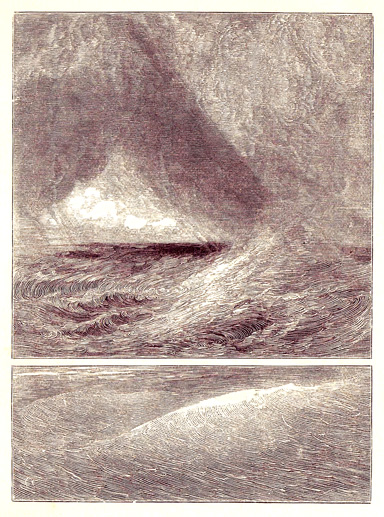On the one hand, as we meanwhile know, the subsequent close collaboration between Dickens and his illustrator Fildes provides the key for solving one of the most prominent puzzles in crime literature: Only due to the exegesis of the title illustration was it possible to reconstruct the last chapter of the detective story "The Mystery of Edwin Drood" which remained unwritten on account of the author’s death.[1] Another, no less far-reaching consequence of this cooperation was the famous portrait of Dickens in absentia, which was spontaneously drawn by Fildes when he went to meet the author to discuss the final illustration of the Drood murder case but only found Dickens’s empty chair. The effect of this picture on Van Gogh is well-known.[2]
However, what had a much more substantial influence on Van Gogh’s artistic development was the third consequence of Fildes’s rejection of the reportage commission. For the publisher Thomas now had to fall back on a draughtsman whom he held in high esteem artistically, but whom he apparently found to be less reliable. In the second issue of “Graphic”, Arthur Boyd Houghton made his first appearance with a double-page depiction which was engraved by no less a person than the publisher himself. Besides Millais, Houghton was one of the top-class engagements in the artistic staff of the young illustrated magazine. He had already made a name for himself with a whole series of successful publications of the publishing house of the Brothers Dalziel. Along with other members of the extended family, the two engravers Edward und Thomas Dalziel had operated the most successful xylography enterprise of the Victorian age. There was hardly an illustrated journal that was not supplied by their factory, and hardly an artist from the Pre-Raphaelite context who wasn’t involved in their endeavours.
Houghton participated in many of their illustration projects. Most widespread were his magnificent pictures to the “Illustrated Arabian Nights Entertainments” from 1863. As an artist of Anglo-Indian descent, not least due to the large fund of Oriental costumes which he possessed, Houghton preferred to visualize themes that catered to the audience’s taste for the exotic. [3]

A.B. Houghton, Sheik Hamil (Selfportrait as a blind visionary)
Detail, ca. 1870
The drawing with which he presented himself to the “Graphic” readers, however, depicts an entirely different milieu than the glamorous fairy-tale world to which the Dalziels had committed him. Upon first sight, in both thematic and compositional terms, “Night Charges on their way to Court” could pass for a blueprint of Like Fildes’s gloomy wood engraving “Homeless and Hungry”, with which the previous first issue of the “Graphic” had quite effectively illustrated the socially critical orientation of the journal. In both cases, the outcasts of Victorian society are shown in long rows traversing the picture. Yet while Fildes subjects his homeless persons in a humble posture to the pitying gazes of the puritan readership, Houghton’s crowd of night owls and law-breakers confronts the reproachful looks and abuses of the surrounding passers-by with defiant pride. Not a trace of remorse. Houghton’s depiction was not only a light-footed counterpart to the sentimental and moralising picture program of the social realists, it quite obviously took sides with dissipation and breaching the law. Houghton was known for his excessive lifestyle and his libertarian and anarchist convictions that were constantly directed against puritan bigotry.
 Luke Fildes, Homeless and Hungry, The Graphic, 1869
Luke Fildes, Homeless and Hungry, The Graphic, 1869

A.B. Houghton, Night charges on their way to the Court, The Graphic 1870
Under the roof of the Dalziels, whose products and uniform xylographic style perfectly matched the inwardness of Victorian society, the bohemian Houghton found his hands tied in artistic terms and also in regard to his painterly ambitions; he never succeeded in getting beyond models from the Pre-Raffaelite camp such as John Millais and Holman Hunt. It was only in the field of reportage drawing that he could develop his uniqueness and brilliance by integrating in the broad range of its possibilities and thus reviving the field of the grotesque, in which the social reportage had began in the 18th century with artists like Hogarth und Rowlandson. In Houghton’s works, graphic reportage is at the peak of its expressive means.
With the offer of getting involved in the lengthy report on an entire continent, a creative scope was opened for him, which he made use of in every respect. Houghton’s report was published under the title “Graphic America” starting in March 1870 at irregular intervals for a period of close to three years. The literary model of this drastic, socially critical panorama that Houghton unfolded here was provided by Charles Dickens’s account of his trip to America, published in 1842 under the title “American Notes”. The uniqueness of the endeavour in artistic terms was immediately perceived.
According to the Victorian art critic Harry Quilter, “’Graphic America’ was probably the best pictorial record of a visit to a strange country which ever appeared in a newspaper.”[4] However, in the second year of publication Houghton’s America report was already faced with top-class competition in the form of the Gustave Doré’s successively published, comprehensive travel reportage “London Pilgrimage”. But Doré’s monumental and extremely effective big city panorama, which also followed in Dickens’s footsteps, lacked the wide range of artistic facets that Houghton had to offer as well as his satirical sting.
In regard to the latter, the editor of the “Graphic”, already after the first instalments of “Graphic America” dedicated to the metropolis of New York, was confronted with a wave of outrage caused by the monstrous distortions which the artist had allowed himself, e.g., by transforming the marches of the New York police on Broadway into a parade of pig-headed and puffed-up automatons, or turning the election campaigning of the Democratic Party, notorious for its corrupt machinations, into a nightmarish spectacle. Houghton’s picture reportages were only printed in excerpts in American gazettes and partially toned down by means of refined retouching.
The America he perceived in the metropolises was not the promised land, as millions of emigrants imagined, who especially in the second half of the century populated the continent at a phenomenal rate. What he encountered here in the reconstruction phase following the destructions and devastations of the Civil War, was a land of the most blatant social opposites in which, in addition to the economy, corruption and rapacious speculation were also on a dizzying rise.
In New York, Houghton contacted Charles Parsons, the legendary art director of “Harpers Weekly” who had emigrated from England and grouped around him an excellent circle of reportage draughtsmen and young illustrators including Winslow Homer, Howard Pyle and Edwin Abbey. The network of New York contacts, which Houghton according to his own words had at his disposal, but never specified any closer, most probably also included one of his publisher’s closest friends, the caricaturist of Harpers Weekly, Thomas Nast, who was originally from Germany. In his New York drawings, Houghton pursued his caustic humour and vicious stroke.
One can furthermore presume that William James Linton, in whose workshop the publisher of the “Graphic” had learned xylography, belonged to the circle of New York contacts. In the mid-1860s, Linton had emigrated to America and after a short time already gained an excellent reputation in New York as a master xylographer and political commentator. During the period of Houghton’s stay, he was in the process of quitting his job as art director at “Leslies Weekly”, the journal competing with “Harpers Weekly”, to start his own publishing project, for which he had his student Alfred Harral come to America. Since Harral was also one of the main engravers of Houghton’s drawings, contact to Linton was more than probable.
After a month, Houghton left the metropolis of New York and set off on a journey westwards, which – as already announced in the “Graphic” – was to lead him along the new Union Pacific line to San Francisco. Like Dickens before him, he first travelled to Boston and then to New Lebanon in New York State, where the Shaker sect had its centre. Thanks to the untiring journalistic activities of their charismatic leader Frederick Evans, the radical, social reformatory ideals of the community had gained political influence during this time. Evans is also the main figure of a series of pictures in which Houghton documents an evening mass of the Shakers in three phases. These drawings rank as the best known works of “Graphic America” and were also reproduced in many American illustrated journals including “Harpers Weekly” and “Every Saturday”. Although the depictions seem to be carried by sympathy for the radical Christian commune, the Shaker Evans vehemently protested against them and demanded that the responsible editors take steps against the artist. It seems to have been clear to him that the atmospherically extremely dense depictions of the communal spiritual trance and the very subtle characterisations of the depicted persons did not serve as a worthy representation, but that in all details they were part of a picaresque overall endeavour.
The eerie, somnambular atmosphere which Houghton lends the scenes fascinated the collector of engravings Van Gogh. He saw a parallel to Goya in this, and many details in Houghton’s works – for example, the characterizations of the Shaker women seen in the background of “Shaker Evans at Home” – indeed give rise to the assumption that Houghton knew Goya’s “Los Capricos” quite well. And Van Gogh also discerned a second, contrary element in Houghton’s work which is also applied in the Shaker drawings, namely, a cool, distanced objectivity, “a surprising plainness”, that reminded him of Charles Meryon. But what astounded him most was the strange character of Houghton’s works, the suggestive use of hatching elements. In the case of the Shaker drawings, they are set in a sort of feverish vibration so as to convey the atmosphere of the state of trance the community works itself into. In regard to these subtle means of expression, Houghton’s works reminded him more of etchings than of wood engravings. And the further he pushed forward to the West, the more the originality and the expressive power of this strange hatching technique seem to have increased.
In a Pawnee reservation in Nebraska, Houghton was witness to the slow decline of a community of Native Americans, who were addicted to alcohol and gambling. In the drawings he made in the tents of the Pawnees, the impression of ominousness and somnambulism predominates. But he was able to see a “permanent poetry” in the Indian way of life, to which he felt close.[5] As the next leg of his journey, he planned a lengthy buffalo safari in the expanses of the prairie, for which he hired young William F. Cody as a scout. Cody was just finding fame as a hero of dime novels under the pseudonym Buffalo Bill[6] .
In the documentary drawings of this hunting adventure, perspectival space is unfolded in a grid of two-dimensional segments, leaving the draughtsman and engraver enough room to translate the impressions of nature into a firework of abstract, wildly flickering hatchings. Despite all diffuse tonality, which upon first sight may call the aquatint etching method to mind, it is precisely these works that retain very characteristic features of wood engraving, namely, the seamless alternation of white and black lineaments as well as a softness caused by the material of the medium and an expressive gruffness.
Most of these engravings bear the signature of the workshop of Joseph Swain, who together with the Brothers Dalziel and Linton counted as the best known and most experienced xylography enterprises.[7] In Van Gogh’s view, who sought to analyse the works of the engravers just as closely as the layout of the drawings themselves, Swain was the “very best”, the epitome of the engraving craft, which in his opinion was still in a position to realize the model drawings as precisely as possible but also with the highest degree of expression. Van Gogh was too unfamiliar with the internal matters of the xylography craft to realize that the old method of wood engraving, which went back to Thomas Bewick, was precisely not what he assumed it to be, namely, a method to as precisely as possible transfer the model drawing in the sense of a facsimile, quite to the contrary: it was a kind of free translation.
The big debate, which commenced in the mid-1860s in the xylographers’ guild and increasingly took on ideological traits, was about the ethical status of the craft, whether the engraver performed a creative work of his own by drawing – as Bewick did – with a gouge, meaning working with the white line, or whether he was a purely mechanical copy engraver of black line models, which due to the photomechanical transfer possibilities of drawings had become commonplace. The great propagandist of the classical white line engraving was William James Linton, who positioned this method in numerous pamphlets and lectures against the new schools of facsimile engraving. He himself counted as one of the most excellent practitioners of this method and in America created illustration works that led the white line engraving to perfection.
It is an open question whether an exchange took place between Linton and Boyd Houghton in New York. But the fact is that the engravings which Swain, and later Alfred Harral, produced according to Houghton’s instructions were expressive masterpieces of white line engraving and ideally corresponded with the direction that William James Linton vehemently propagated.

W.J. Linton, Flood of years, 1877
Van Gogh’s course of development from the toned contour drawings to the energetic hatchings of his Arle phase would hardly have been conceivable without Arthur Boyd Houghton’s engravings as models. The late Van Gogh also shared with Houghton his interest in Japanese prints that exhibitions had popularized in England since the beginning of the 1860s. The “one-eyed artist”, as Houghton liked to call himself, [8] was, in regard to the integration of the Asian spatial experience in his own work, together with Winslow Homer one of the few from the field of illustration who worked in an up-to-date fashion and in parallel to artists such as Manet, Degas or Caillebotte plumbed new ways of harmonising the narrative heritage of historical painting with an almost photographic objectivity and an attitude aimed at making the artistic means autonomous.
At the end of his trip to America, Houghton witnessed a further social-utopian mass movement. In Salt Lake City, he visited the religious sect of the Mormons, whose Old Testament system of polygamy stood in stark contrast to the New Testament system of celibacy, which he had just got to know with the Shakers. The claustrophobic apprehensiveness that his drawing of church attendance in the Mormon tabernacle radiates already points to an upcoming reportage in which he gave the readership of the “Graphic” an account of another foreign country – this time, however, situated in the immediate vicinity. Without having carried out the original plan of traversing America along the recently completed Union Pacific route, in spring of 1870, after a half-year stay in North America, be was surprisingly called back to the London editorial office. The reason being that a military conflict was looming between expansion-addicted Prussia and the autocratic regime of Napoleon III. For the young illustrated journal, it was vital to effectively report on the war to maintain its hold against the powerful competition. And Houghton’s deployment was of great importance especially due to the experiences he had gained as a special artist, or special, in America.
Pandemonium Paris
In early August, Houghton found himself in Paris, which merely a month later, after the French were defeated at Sedan, was surrounded by Prussian troops. The siege was a first-class press spectacle. Correspondents from all big international papers were in the city and sent their news via airmail – carrier pigeons or balloon couriers – over the heads of the besiegers to the outside. The reporters lived in constant danger of being arrested as alleged spies when drawing up their reports, or of being lynched by an outraged mob. The specials developed specific techniques to prevent this from happening. It is known of William Simpson, who was on site for the Illustrated London News, that he did his sketches in a booklet of cigarette paper so that he could roll cigarettes with them if he were to be discovered. Houghton depended more and more on his phenomenal eidetic memory and absorbed the visual impressions on location to then put them on paper later on.
The implosive, panicky mood in the French capital only increased following the capitulation in January. Parisian intellectuals, along with parts of the workers and craftsmen, offered massive resistance to the conservative transitional government. After large parts of the national guard also joined this revolutionary movement, the national assembly withdrew to Versailles and left the metropolis to the self-administration of the Parisian Commune for three month.
In the drawings that Houghton made of this situation, one again encounters the threatening, Goya-like moment of his America reports in an intensified form.
His depictions of demonstrations and assemblies of women of the Commune, the so-called “vengereuses”, who decisively contributed to the constitution of the revolutionary resistance, turn out to be accounts reminiscent of medieval witch festivities on the German Blocksberg mountain, and the building of barricades against the approaching Versailles troops resembles the vision of a black-magic, apocalyptic finale. The vividness with which he depicted these scenes was entirely unique in the area of illustrated journal graphics.
Through their international dissemination, these bizarre engravings showing the protagonists of the revolution in a state of hysterical delirium substantially contributed to the demonization of the events of the Commune.
Half a year after the bloody suppression of the revolutionary movement through a concerted action by the Versailles government and the Prussian occupiers, resulting in an unprecedented mass execution, Houghton was again sent to France by the editors of the “Graphic” to be present at the trial of the Versailles government against a number of women who were charged of being active during the revolutionary months as arsonists – so-called “pétroleuses”. Houghton’s caricature-like reporting is similar to the drawn observations of simultaneously present Gustave Doré, also in regard to the contempt for the Versailles courts which he expressed. [9]
Traces covered over
After his death, Arthur Boyd Houghton, who in the last years of his life had been dismissed by art critics as an eccentric and given up by his own family due to his excessive way of life, quickly belonged to the best forgotten artists of the Victorian age. Entire work groups got lost in the fog of untraceableness and almost all biographical documents were discarded, so that as early as in 1921, a discouraged art historian doing research on the Victorian art of illustrated journals had to establish that there was no artist’s biography that was documented any worse than his. [10] Paul Hogarth, who himself was one of the most committed social reportage draughtsmen of the 1950s and 60s, in his research even had the suspicion “as if there was a conspiracy to destroy all traces of Houghton.”[11]
Van Gogh by no means belonged to the artists who agreed with Houghton’s cynical view of the world, and his highly refined fashion of drawing was also far from him – in both respects he was much closer to rustic romantics like Millet or Jules Breton and sentimental social realists like Walker, Herkomer or Fildes. Yet in regard to the enormously captivating effect of many of his works, created by an atmospherically dense fabric of rhythmic bundles of lines, no other artist fascinated him more than Houghton. In his view, limits to the possibilities of expression of an artistic medium were abolished, and that is precisely what he himself aimed for in the following years of his development.
What an exceptional phenomenon Houghton’s art was for him and to what degree it inspired his own development is expressed in a letter to his brother Theo, in which he writes about the mysterious side of Houghton’s art. He sees a special category of the good and beautiful at work in his art, a “lasting truth” – even if it is hardly or not at all acknowledged – “which can give energy to whomever wants it.”[12]
In the MePri Collections
Laurence Housman, Arthur Boyd Houghton, London 1896
Paul Hogarth, Arthur Boyd Houghton, London 1981
Paul Hogarth, The Artist as Reporter, London 1967
Paul Hogarth, Artists on Horseback, New York, 1972
Peter Johnson, Frontline Artists London, 1978
Sinclair Hamilton, Arthur Boyd Houghton and his American Drawings, in: The Colophon, No. 02, 1939
Harry Quilter, Some Graphic Artists, Universal Review, 1888
The Brothers Dalziel, A Record of Work 1840 – 1890, London 1901
Eric de Mare, The Victorian Woodblock Illustrators, London, 1980
Joseph Pennell, die Moderen Illustration; Leipzig, no year
Joseph Pennell, Pen Drawing and Pen Draughtsmen, London - New York 1889
Charles Dickens, American Notes, Ausgabe London 1892
Frederic G. Kitton, Dickens and his Illustrators, London 1899
Charles Dickens / Luke Fildes, The Mystery of Edwin Drood, London edition, 1914
_____________________________________________________________________
Portfolio with individual sheets from A.B.H.
“Graphic America” and “Paris under the Commune” in: The Graphic, Harpers Weekly, Every Saturday
[1] Fruttero & Lucentini, Charles Dickens, La vertità sul caso D., Turin 1989
[2] See MePri contribution: Unleashed Xylographism. The influence of illustrated journal graphics on the art of Vincent van Gogh.
[3] The Brothers Dalziel, A Record of Work 1840 – 1890, London 1901, p. 222
[4] Harry Quilter, Some Graphic Artists, Universal Review, 1888
[6] Paul Hogarth, Arthur Boyd Houghton, London 1981, p. 99
[7] Ned Buntline, Buffalo Bill, King of the Border Men (from 1869 on)
[8] Swain's workshop had supplied the caricature magazine "Punch" for years, which made it especially suitable for collaborating with Houghton.
[9] In his travel sketchbook, he calls himself "the one - eyed artist in America". (see Hogarth, ABH, S. 65)
[10] Doré's drawings could only be printed years after his death in Paris in 1907 under the title: Gustave Doré, Versailles et Paris en 1871 d´apres les Dessins originaux.
[10] E.J. Sullivan, Art of Illustration, 1921
[11] Hogarth, ABH, p. 8
[12] Letter 262